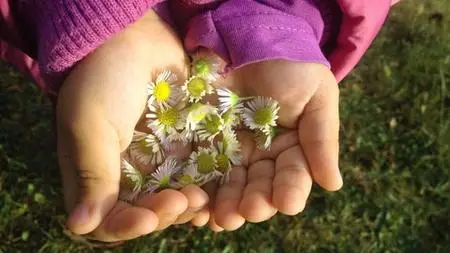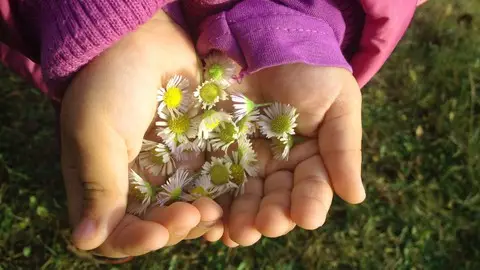Inspired By Reggio Emilia: Language Of Open-Ended Materials
Published 9/2023
MP4 | Video: h264, 1280x720 | Audio: AAC, 44.1 KHz
Language: English | Size: 2.16 GB | Duration: 1h 51m
Published 9/2023
MP4 | Video: h264, 1280x720 | Audio: AAC, 44.1 KHz
Language: English | Size: 2.16 GB | Duration: 1h 51m
Teaching Strategies in Early Childhood Education
What you'll learn
This is a second tier course designed for educators working towards their associate or master degree in Early Childhood Education.
Section 1: The Language of Open-Ended Materials
Section 2: High Sensory Learning Experiences and Play Schemas
Section 3: The Language of Recycled Materials
Section 4: The Language of Drawing and Artistic Materials
Section 5: Keeping It Open-Ended
Requirements
Please consider INSPIRE BY REGGIO EMILIA: A New Beginning before enrolling in the course. This is a second tier course.
Designed for educators working in early childhood settings, centers and homeschooling learning environments.
Those seeking a deeper dive into Reggio Emilia inspired classrooms.
Description
Course is 1 hour and 50 minutes.INSPIRED BY REGGIO EMILIA: The Language of Open-Ended MaterialsAt Reggio Emilia inspired schools, we believe in our desire to connect to others we use many languages. Ironically, most languages we use are not spoken. This is particularly true for young children. As teachers we are diligent about listening to the many languages of children. Materials and engaging activities help us to listen to children, help us to know them well. It is through the artistry, the song and dance, the imaginary play and construction that we hear and see children.In this course we will examine the use of open-ended materials as a strategy to draw out the desires and stories of children. Open-ended materials are used as a creative agent, a material or tool which has no predetermined outcome.SECTION 1: An Introduction to the Language of Open-Ended MaterialsOne of the most powerful innovations from the schools of Reggio Emilia is the use of open-ended materials as tool to create, to tell children’s stories.The practice of using Open-Ended Materials allows children to create and re-create. They become masters of construction, mastering new found language and storytelling.This course is designed to guide teachers and teaching teams in a deeper understanding of this practice. It is my hope that teachers will act like researchers. With intention we create beautiful and irresistible invitations, drawing children to the table of learning.This course is built off a framework for creating provocations using open-ended materials. Be sure to download the Educator Guide to this course.Lectures:Environments as InvitationsCourse Study Guide: A Teacher’s GuideCourse OutlineDownload: Course Study Guide: The Language of Open-Ended MaterialsSECTION 2: High Sensory Learning Experiences and Play SchemasHigh sensory, multi-sensory learning experiences provide the best opportunity to teach across the curriculum. In this section we examined high-sensory provocations using open-ended materials.Sensory play plays an important role in child development from birth to early childhood. It helps build nerve connections in their brain’s pathways, developing the child's ability to stay on task, manipulate objects with their hands, and control their own body movements.MULTI-SENORY EXPERIENCESMultisensory instruction is a way of teaching that engages more than one sense at a time. For example, say a class is studying apples. Kids might have the chance to visually examine, touch, smell, and taste apples — instead of just reading and listening to their teacher speak about how apples grow. Then they might hold a halved apple and count the number of seeds inside, one by one. Making it real is how we learn deeply.Lectures:Play SchemasThe Language of Natural MaterialsThe Language of ClayThe Language of PaperDownload: Play Learning Schemas; Explore Nature with Observational Drawing and Scientific Thinking; Promoting Creativity for Life Using Open-Ended Materials; The Tallulah Project: Bridging Our Communities with ClaySECTION 3: The Language of Recycled MaterialsOur classrooms have mini-ateliers that contain many open-ended materials, lending themselves to creative outcomes. In this video a young man creates a robot using plastic bottles, bottle tops and tape.Our focus is no longer on buying commercial supplies from catalogs. Instead we buy things that help children put things together like tapes, wire and adhesives.In this section we not only show you how to set up these provocations but also discuss how your school can establish your own recycling center.Lectures:Robots in the MakingCreating with Recycled MaterialsGetting Started with Your Own Recycle CenterDownload: Beautiful Stuff Letter to Parents; Using Open-Ended Materials; Asking Open-Ended QuestionsSECTION 4: The Language of Drawing and Artistic MaterialsDrawing in an observational skill. It is the basis of science and artistic expression. As such, the schools of Reggio Emilia remind us - in our screen filled lives - we must once again take up the pen and paper.Plain white paper and a wide variety of writing tools create an open-ended learning experiences. It is a chance for children to create their own stories in their way.Lectures:The Language of DrawingThe Language of Artistic MaterialsCreating StorybooksLiteracy Rich Learning EnvironmentsOpen-Ended Materials and StorytellingThe Language of Drawing: Tools of the TradeDownload: The Beauty of Observational Drawing; Why Children Should Ne Given the Opportunity to Tell Stories; Checklist for Literacy Rich Classrooms; The Art of Eric Carle Educator Guide; Writing Tips for ParentsSECTION 5: Keeping It Open-EndedIn this section we take a strong look at classroom design from lighting, to colors, to furniture. We examine innovative architecture emerging in the field.In this section you will find the MUST HAVE BOOKS listing, references books referred to in this course.Lectures:Displayed by DesignInspiring Spaces for ChildrenRethinking School DesignBeautiful Stuff! A tribute to Cathy Topal and Lella GandiniMust Have Books ListOn ReviewDownload: Must Have Books; Beautiful Stuff from Nature Chapter: Outside and Just Beyond the Classroom DoorThis course includes a Learning Guide and several peer reviewed articles providing more examples and content related to the teaching strategies that use open-ended materials.When considering creating this course, I was immediately concerned that teachers would look at the classroom photos and try to replicate what they were seeing. The old "make and take" kind of professional development. It is my hope you will seek deeper knowledge of this approach to teaching and learning.For us, the photos and video are simply representative of the underlying principles and deep understanding of children’s thinking, questions, and curiosities. To be sure, they are spaces that tickle our imagination, engage all of our senses, and invite investigation. If we are to promote this type of environment, then we must go deeper than what is merely seen at eye level.The Reggio Emilia approach views the learning environment as a powerful protagonist, shaping a child’s identity. It is a way of teaching that views the child as a powerful player in their own learning. It is a belief we share. We believe a teacher’s role is to draw out what the child already knows, already wonders. The use of open-ended materials and the way we offer these materials is essential to our practice.Welcome to class!Mary Ann Biermeier, M.Ed.
Overview
Section 1: Introduction: The Language of Open-Ended Materials
Lecture 1 Environments as Invitations
Lecture 2 Course Study Guide: The Language of Open-Ended Materials
Lecture 3 Course Outline
Section 2: High Sensory Learning Experiences
Lecture 4 High Sensory Experiences and Play Schemas
Lecture 5 The Language of Natural Materials
Lecture 6 The Language of Clay
Lecture 7 An Introduction to Clay as an Open-Ended Material
Lecture 8 The Tallulah Project: Bridging Our Communities with Clay
Lecture 9 Clay in our Classrooms
Lecture 10 The Language of Paper
Section 3: The Language of Recycled and Natural Materials
Lecture 11 Robots in the Making
Lecture 12 Recycled Materials: A Provocation to Create
Lecture 13 The Language of Open-Ended Materials: Desert Stories
Lecture 14 Getting Started with Your Own Recycle Center
Section 4: The Language of Drawing and Artistic Materials
Lecture 15 The Language of Drawing
Lecture 16 The Language of Artistic Materials
Lecture 17 Creating Storybooks
Lecture 18 Literacy Rich Learning Environments
Lecture 19 Open-Ended Materials and Storytelling
Lecture 20 The Language of Drawing: Tools of the Trade
Section 5: Keeping It Open-Ended
Lecture 21 Displayed by Design
Lecture 22 Inspiring Spaces for Children
Lecture 23 Rethinking School Design
Lecture 24 Beautiful Stuff! A Tribute to Cathy Weisman Topal and Lella Gandini
Lecture 25 Must Have Books! A Book Review
Lecture 26 Must Have Books! The Complete List of Books References in this Course
Lecture 27 On Review
This is a second tier course designed for educators already working in the field of Early Childhood Education.,Implement teaching strategies which support the creative and inventive nature of children.,Build on your knowledge of relationship driven learning environments.



